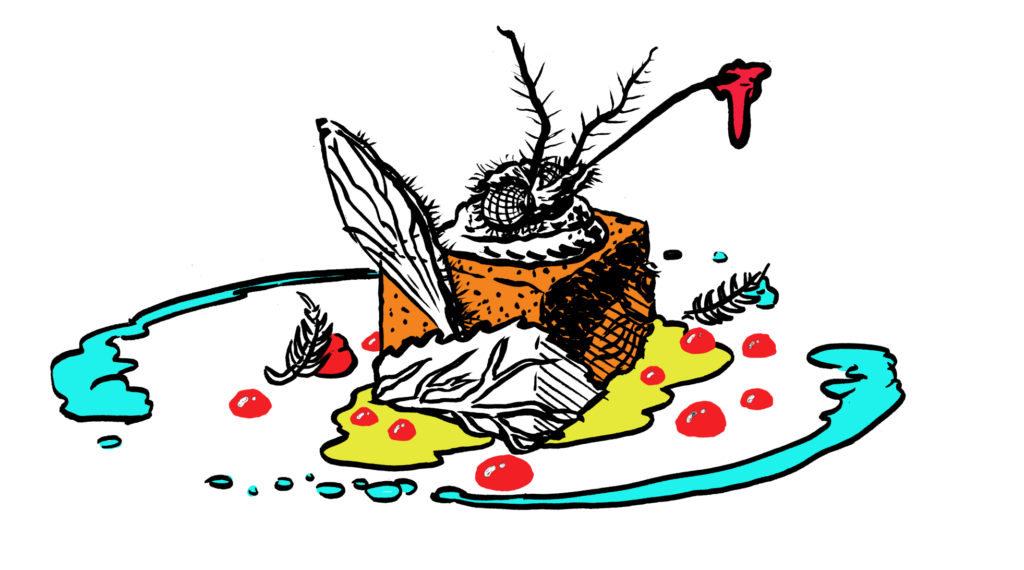

That’s how I arrived at Pujol, the flagship restaurant of chef Enrique Olivera. This came at the end of weeklong trip around Oaxaca. Pujol was meant to be the finale of the whole trip; to see how the culmination of Oaxaca’s and Mexico’s food was being “elevated.” Aside from that, I had never been to a restaurant of this caliber – the 9th best restaurant in the world, to be exact.
So, naturally I had certain expectations for a place like this. I am attuned to the intricacies of a restaurant service, the customers, the signs and signals of excellence as well as burn-out. At a top-50 restaurant I expect a level of exceptionalism to the point where the seams of service are so finely stitched together that a person such as myself wouldn’t be able to see where they might’ve been.
I had certain expectations for presenting myself as well. But, I don’t own a suit or even a pair of slacks, so I donned my best button-up, cleanest pair of jeans, concealed my kitchen wounds as best I could and decided to play a rich guy bumming it for a late lunch at Pujol.
The restaurant itself is unassuming, like an exclusive Eye’s Wide Shut sex den for the rich and powerful or simply another home in this affluent neighborhood. Inside, it’s like almost every restaurant in Mexico. It opens to a spacious courtyard abound with plants, flowers, and fruit trees. This seems to be a standard for every restaurant in Mexico – unassuming exterior leads to a gorgeous and lush interior. They feel, to some degree, as if they’re inviting you into their home. Pujol has a similar atmosphere, but something closer to subdivision demo house or an architectural showcase – the designer chairs, the books on the waiting area coffee table, the waiting area itself, the manicured tree jetting up from the indoor rock garden and the lighting that casts stark shadows onto the tables. It immediately signals that this place is high class, elegant, refined. Not necessarily homey. Maybe for the rich though. Maybe that’s how they feel comfortable. I don’t know. For me, home is where the rats live in the walls.
The maitre d’ guides me to my table and even though I know she can smell fryer grease through my clothing, I try to remember I’m playing a part. There’s no menu, no drink list, just servers. A shit load. They swarm like bees around a broken hive. This here is a hell of a performance. With every course, the food-runners march from the kitchen in tandem and split formation as they approach a table. Surrounding the diners and taking a cue from a single coordinated glance, synchronized, they drop the plates in front of the guests at once. The bartenders skillfully and near-silently mix drinks. The servers eloquently explain ingredients and techniques and expertly direct customers away from what they wanted to what they need.
One of them approaches me, arms hidden behind their back, and asks what I’d like to drink. Red wine, I say, and that’s it. Fine dining isn’t about choice, apparently. You’re paying to eliminate choice, to be served.
The opening dish arrives with production value. Not a plate or bowl, but a gourd. It’s a dish I’ve seen on that chef show that I hear customers talk about a lot at my job. Billows of smoke will clear to reveal two cobs of corn…or something like that. They remove the top and sure enough, two tiny corncobs rest atop a pillow of corn husks, whips of steam curling and quickly dispersing.
It tastes like corn, straight from the stalk, no seasoning. My initial reaction is to say it’s boring, it’s bland, but maybe that’s what I’m supposed to think. They’re trying to tell me something – the fundamental foundation of Mexican cuisine – something in that vein. I think they’re…right? They must be. All I know is I’m new to dining on this level.
Before I could really think about it a runner silently swipes up the gourd and a new server delivers the next course. A tostada layered with thin medallions of scallops and colorful discs of heirloom grape tomatoes. It’s got the two most common traits I’ve come to associate with high end cuisine from reading books: beauty and subtlety. The plate is gone as soon as the last bite is down. Next comes a crudo of kanpachi and star cactus. After, an eggplant with puffed rice hidden under a thick black sauce glossy from emulsified butter.

Yet another new server appears, like they’re reproducing in the kitchen. I ask for another glass of wine. Something with a little more punch, a little more flavor, I say, trying not to use words like crude or dumb to refer to myself. The server advises me to stick with this wine. It develops, he says. When I disagree mildly, he motions over the sommelier who informs me I’m moving into the more intense dishes and that the best wine would be the one I had before, the one he’s pouring now. It feels to some degree like they’re trying to keep the show moving or at least preventing me from slowing it down. I’m not sure, but I’m on my best behavior, though, straightening my utensils, wiping the table, folding my towel like a good line cook. The staff are scrambling like there’s an emergency they don’t want anyone to know about. They must be doing a good job, because I can’t see anything wrong, but it’s engaging to watch. Like a dance performance.
The youngest server yet arrives. The Mexican Harry Potter explains “what we have here” is their famed mole dish and a basket of blue corn tortillas, but all I’m hearing is a buzzing around my ear. A part of the music, a vibrating phone? No, it’s a mosquito. A pretty big one. He keeps explaining the age of the mole – 3000 days or something like that – but I’m not really paying attention. I’m tracking the mosquito flying around his delicately interlaced fingers. It swerves chaotically in and out of his view, the noise undeniable. He can tell I’m not listening, not looking at him. He has too, but he powers breathlessly through his practiced speech and extends an open hand in invitation – enjoy. The mosquito floats down Harry’s palm and settles on top of the finger tips before they’re snatched away. Then, it’s just me and the mosquito.
How did he not hear it or see it? Or did he, but won’t acknowledge it? Is this standard procedure? Does this happen often? Or is this ability to deny reality in favor of a pristine experience just top-tier service?
Of course there were mosquitos. There was a massive garden surrounding the place and they left the doors open throughout service. Not unlike a shit stain in the toilet, it’s not technically out of place, but it doesn’t feel like it belongs at Pujol. It seems like a restaurant that has thought everything through, from design to layout to execution to presentation, wouldn’t overlook something like this.
Why weren’t they doing anything about it? Sure fly swatters and electric bug catchers would ruin the aesthetic, but I’m sure they could manage to get some specially designed by a famous artist. Bug spray is an obvious option, but then there’s the smell. Maybe tiki torches might be the best to blend in with the decor?
The mood lighting made the mosquito difficult to track but maybe that was the point. I target one between my palms – CLAP – and he escapes. I spot another over the tortillas – CLAP – and he escapes. It’s surprising to find that no one notices or cares what I’m doing.
The more I think about it, the more mosquitos I spot. I realize they have no interest in fixing this problem. For them, it doesn’t exist. I was witnessing a great conflict in the fine-dining industry – the desire to solve problems v.s. the preservation of the show for the customer. In the ninth best restaurant in the world with three mosquitos swirling round me as I ate a 3000 day old mole, I knew which side they were on.
They escort me outside for dessert, which was a pretty fitting way to go since mosquitos aren’t out of place in a garden. Businessmen smoke cigars. A couple blows out candles on a coil of churro. Customers settle deep in their seats, eyes glazing over. A clown horn honks relentlessly on the street. I know from experience a man on his bike is selling sweets. Outside this place that noise is very much a part of Mexico. It’s normal. In here, it feels bizarre. More bizarre is that no one aside from me seems to hear it.

Pujol feels like an oasis of time and space – or at least it’s designed to be. A ton of money was spent here to cultivate a specific experience. It wants to shield you from anything the chefs and creators have not crafted, but that’s an impossible feat. Fine dining on this level, I’m realizing, seems to be more about the fantasy. If its about service, nuanced touches, design and style and precision of a purely cultivated experience, then it seems to me fine dining is more a performance than it is a meal. And much like hypnotism, you have to be a willing participant in order for the fantasy to take hold.
The show is a part of any food establishment, from fine dining to street vendors. For me, the show and the food are inseparable. So much so, they should bleed into each other. So, why should the show of it all pretend to be something polished and pristine when eating tacos on broken plastic stools on a sidewalk can just as easily and more enjoyably include mosquitos as well?